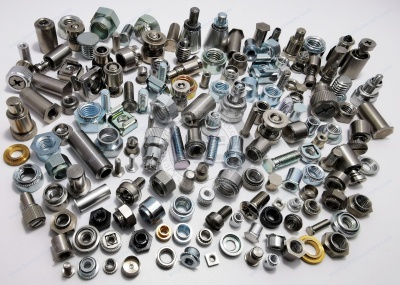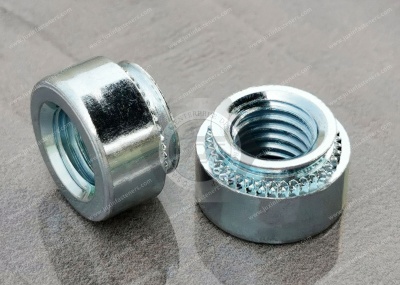Call Us
+86 136 6007 9809
Call Us
+86 136 6007 9809
Jun. 09, 2024
Automotive Fastener Installation Solutions on Metal Panels
Threaded Fastening
1. Threaded Connection without Nut
For components with thicker sections or blind holes in metal sheets, bolts or screws can be directly tightened. However, due to the thinness of the metal sheet, applying tightening torque can easily deform it, making it unable to clamp the sheet securely. This may lead to thread loosening or indentation on the connected surface. While simple, this type of connection lacks reliability. For high-quality carbon steel welding nuts fasteners and professional technical support, don't hesitate to contact us at adelajonly@gmail.com or visit our website at [Juxin Fasteners]https://www.juxinfasteners.com.


2. Connection with Regular Nut
A standard method involves using regular bolts with nuts to connect metal sheets and other components. Adequate wrench space is required during assembly, and the thickness of the connection should not be too thin. Alternatively, welding bolts or studs can be used by welding them onto the metal sheet, installing the connected parts, and securing them with regular nuts. This method is simple and easy to assemble, suitable for single-side connections. However, problems with being unable to clamp the metal sheet and affecting connection reliability still exist.
3. Connection with Fixed Nut on Metal Sheet
Pre-fixing nuts on metal sheets and then directly connecting them with bolts or screws during assembly improves connection efficiency and reduces the risk of thread loosening. Various methods exist to fix nuts on metal sheets, including welding, riveting, stamped, spring, and embedded plastic nuts.
Welding Nuts: Similar to welding bolts, consideration should be given to the weldability and welding process of the metal sheet. It provides high connection strength, and care should be taken during assembly to avoid deformation of the metal sheet.
Riveting Nuts: Requires specialized installation tools and pre-drilled holes. Common pre-drilled hole shapes include circular and hexagonal. Hexagonal riveting nuts are designed to prevent self-rotation more effectively.
Stamped Nuts: No pre-drilled holes are required; they are directly punched into the metal sheet and fixed using part of the nut riveting head
This method offers high production efficiency and reliable connections but involves high equipment investment costs.
Spring Nuts are held on the metal sheet by spring clips. They have lower positioning accuracy and are typically used for non-critical component connections.
Embedded Plastic Nuts: Used in conjunction with plastic self-tapping screws, the screw squeezes the plastic out upon insertion, expanding the nut to grip the metal sheet. It provides lower connection strength and is suitable for fixing non-metallic plates and decorative components.
4. Considerations for Threaded Fastening
When using threaded fastening, considerations should be made to prevent thread loosening. Preload force control and pre-applied locking adhesives can generally address this.
Self-tapping Screw Fastening
Self-tapping screws are commonly used for connecting metal and non-metallic thin plates. However, their connection strength is relatively low due to the influence of thread on the gap between plates. Limiting the number of connected plate layers to no more than four is recommended. Pre-drilled pilot holes are required for self-tapping screws. When operating in inconvenient environments, self-drilling self-tapping screws can be used to skip the step of pre-drilling pilot holes, thereby increasing individual connection efficiency. However, self-drilling self-tapping screws generate significant noise during insertion, making them unsuitable for mass production and detrimental to the protection of operators in the operating environment.
For plastic components, unlike regular self-tapping screws, the threads of plastic self-tapping screws are staggered high and low, which facilitates the gripping of plastic parts and ensures deeper embedding.
1. Riveting: Riveting is suitable for connecting large metal coverings where connections are non-detachable. Compared to threaded fasteners, riveting offers economic advantages and reduced weight. The riveting process is easy to control and does not adversely affect the mechanical properties of the connected materials. However, rivet holes weaken the cross-sectional strength of the connected parts, and the rivet fastening force is smaller than welding. Therefore, its compactness and fatigue resistance are inferior to welding. Increasing rivet density or using rivet groups can typically meet strength and fatigue requirements.
Riveting limitations include its unsuitability for connecting overly thick materials and its limitation to 4 layers of the connected part. It is mainly used for fixed connections in structures with shear forces rather than tension. Additionally, care should be taken not to sandwich high-strength parts between low-strength ones, and thicker, stiffer parts should be arranged on the outer side. For softer materials, consider using plastic rivets.
2. Snap Fasteners: Plastic snap fasteners are commonly used for connecting interior components or lightweight parts on metal panels, such as plastic decorative components like body side panels. They lack conductivity, are corrosion-resistant, have low thermal conductivity, and are non-magnetic, which makes them suitable for applications with relatively low connection strength requirements. Due to their simple structure and low material and processing costs, they are ideal for mass production and wide application.
Conclusion
While threaded fastening is widely used, attention should be paid to preventing thread loosening. Threaded connections have a larger secondary load-bearing capacity but do not always effectively bear loads. As the application of plastic components continues to grow, selecting appropriate standard components is crucial for metal sheet connections. The quality of connections directly impacts the reliability and durability of the final automotive product.
Contact Us
Tel.:
+86 020 8621 0320
+86 020 3121 6067
Technical Support:
Navigation
SEND INQUIREY